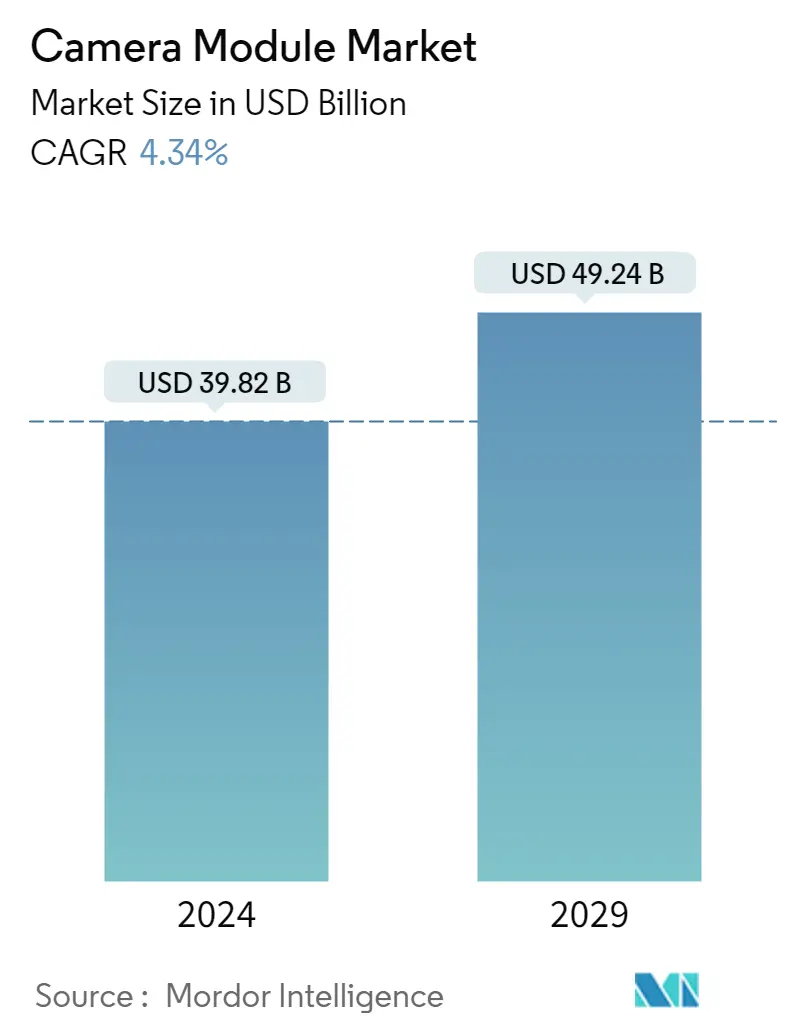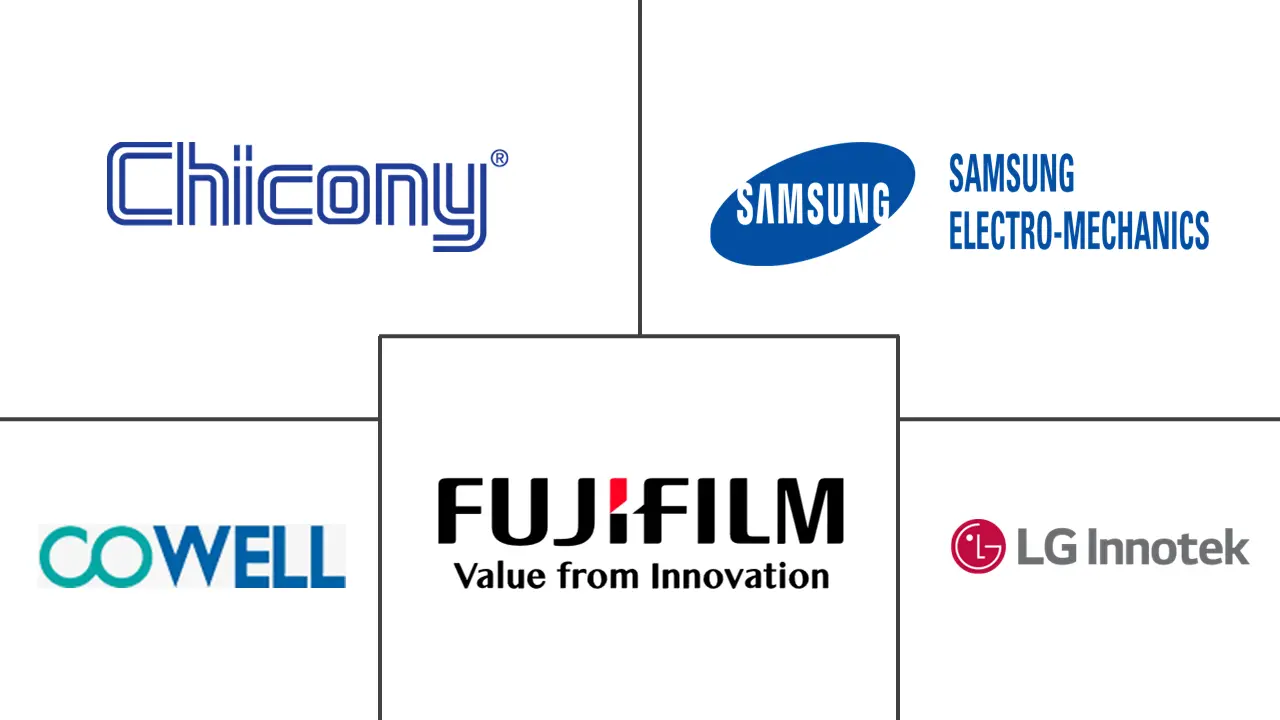Market Size of Camera Module Industry

| Study Period | 2019 - 2029 |
| Market Size (2024) | USD 39.82 Billion |
| Market Size (2029) | USD 49.24 Billion |
| CAGR (2024 - 2029) | 4.34 % |
| Fastest Growing Market | Asia Pacific |
| Largest Market | Asia Pacific |
Major Players
*Disclaimer: Major Players sorted in no particular order |
Camera Module Market Analysis
The Camera Module Market size is estimated at USD 39.82 billion in 2024, and is expected to reach USD 49.24 billion by 2029, growing at a CAGR of 4.34% during the forecast period (2024-2029).
Camera Module Market: A Comprehensive Analysis
- Surge in Advanced Driver Assistance Systems: The camera module market is experiencing significant growth, primarily due to the rising demand for Advanced Driver Assistance Systems (ADAS) in vehicles. Forward camera systems play a crucial role in ADAS by providing advanced sensing capabilities for safety features like lane-keeping assistance, automatic emergency braking, and adaptive cruise control. The increasing reliance on ADAS is prompting industry players to invest heavily in research and development (R&D) and collaborations. For example, Xilinx Inc. and Motovis collaborated to integrate the Xilinx Automotive Zynq system-on-chip platform with Motovis' convolutional neural network IP for vehicle perception and control through forward camera systems.
- Sunny Optical Technology and Valens Semiconductor partnered to incorporate MIPI A-PHY-compliant chipsets into next-generation camera modules for ADAS applications.
- Magna International launched surround-view cameras and electronic control units, making 3D surround-view technology more accessible to consumers.
- Foresight Autonomous Holdings signed a joint proof of concept with a Japanese Tier One supplier to enhance ADAS performance.
- Rising Security Camera Adoption: The growing use of security cameras in both residential and commercial settings is another major factor driving the camera module market. This demand is fueled by the increasing threat of crime and terrorism, coupled with the adoption of IoT-based security systems. For example, the number of installed surveillance cameras in the U.S. surged by 21%, from 70 million in 2018 to 85 million in 2021. Similarly, security system services in the U.K. are projected to generate USD 1,598.84 million in revenue by 2024, up from USD 1,351.9 million in 2019.
- South Korea saw a 200% increase in public CCTV installations, reaching 1,458,465 cameras in 2021.
- Gurugram Metropolitan Development Authority plans to install 1,000 surveillance cameras across 200 locations as part of its smart city initiative.
- Montreal police installed nine additional security cameras in response to rising violent crime rates.
- Technological Advancements Driving Innovation: The camera module market is experiencing rapid technological advancements, especially in mobile photography. Periscope modules have become standard features in flagship smartphones, with manufacturers like O-Film unveiling ultra-thin periscope lens modules. Additionally, Wafer Level Glass (WLG) + Plastic lenses are gaining traction, as seen in Xiaomi’s Redmi K40 Gaming Edition, which incorporates a hybrid WLG camera lens.
- Oppo launched a continuous optical zoom lens offering superior image quality over conventional telephoto sensors.
- Apple was granted a patent for a periscope camera system using prisms, a lens array, and an image sensor.
- Vision Components introduced new MIPI camera modules for medical technology applications, featuring high image resolutions and fast frame rates.
- Market Opportunities and Future Growth: The compact camera module market is on the verge of substantial growth, driven by advancements across applications like smartphones, automotive, and healthcare. The global smartphone market is expanding, with worldwide smartphone subscriptions expected to grow from 6,259 billion in 2021 to 7,690 billion by 2027, according to Ericsson. The automotive sector also presents significant opportunities, particularly with the rising adoption of rear cameras and ADAS forward cameras.
- The average number of cameras per car is increasing, driven by the demand for 360-degree views, cabin monitoring, and e-mirror applications.
- OmniVision and Valens Semiconductor collaborated to develop a MIPI A-PHY-compliant camera solution for automotive applications.
- The healthcare industry is also benefiting, with OmniVision launching its smallest medical CMOS image sensor for endoscopy procedures.
Camera Module Industry Segmentation
The camera module, also known as a compact camera module (CCM), is widely used in security systems, video conferencing, real-time monitoring, and other applications as a video input device. Maturity in photographic imaging device technology, continuous improvement in the network's speed, and advancement in internet technology have boosted the camera module market’s development and growth. One of the prime factors triggering the demand for camera modules is their wide adoption in smartphones, automotive, healthcare, and various other applications.
The camera module market is segmented by component (image sensor, lens, camera module assembly, and VCM suppliers (AF & OIS)), by application (mobile, consumer electronics (excluding mobile), automotive, healthcare, security, and industrial), and geography (North America, Europe, Asia Pacific, and Rest of the World). The report offers market forecasts and sizes in volume (units) and value (USD) for all the above segments.
| By Component | |
| Image Sensor | |
| Lens | |
| Camera Module Assembly | |
| VCM Suppliers (AF & OIS) |
| By Application | |
| Mobile | |
| Consumer Electronics (Excl. Mobile) | |
| Automotive | |
| Healthcare | |
| Security | |
| Industrial |
| By Geography*** | |
| North America | |
| Europe | |
| Asia | |
| Australia and New Zealand | |
| Latin America | |
| Middle East and Africa |
Camera Module Market Size Summary
The camera module market is poised for significant growth, driven by its integral role in various applications such as smartphones, automobiles, and smart home devices. These modules, which include components like image sensors, lenses, and actuators, are essential for capturing high-quality images and videos. The market is experiencing a surge in demand due to the increasing adoption of advanced driver-assistance systems (ADAS) in autonomous vehicles and the rising need for security systems in construction and urban areas. The proliferation of IoT-based security solutions and the growing concern over safety and surveillance are further propelling the market. However, challenges such as high costs and complex supply chain dynamics, particularly in developing regions, pose obstacles to market expansion.
In the Asia-Pacific region, the camera module market is witnessing robust growth, fueled by the region's booming consumer electronics industry and increasing smartphone penetration. The integration of camera modules in consumer devices and the rise of automation and industrial robotics are key factors contributing to this growth. Additionally, the healthcare sector's shift towards digitization is driving demand for camera modules in medical devices. The market is becoming increasingly competitive, with major players like Cowell E Holdings Inc., Fujifilm Corporation, and Sony Corporation leading the charge. Innovations in camera technology, such as Samsung's advanced image sensors and LG Innotek's production expansions, are expected to enhance market dynamics and drive further growth.
Camera Module Market Size - Table of Contents
-
1. MARKET INSIGHTS
-
1.1 Market Overview
-
1.2 Industry Attractiveness - Porter's Five Forces Analysis
-
1.2.1 Bargaining Power of Suppliers
-
1.2.2 Bargaining Power of Buyers
-
1.2.3 Threat of New Entrants
-
1.2.4 Threat of Substitute Products
-
1.2.5 Intensity of Competitive Rivalry
-
-
1.3 Industry Value Chain Analysis
-
1.4 Assessment of Impact of COVID-19 on the Industry
-
1.5 Price Trend Analysis
-
1.6 Ultra Small Camera Module Dynamics
-
1.6.1 Evolution of Camera Module Size Across Various Applications
-
1.6.2 Product Mapping with Resolutions Offered by Various Vendors
-
1.6.3 Resolution Vs. Cost Analysis
-
-
-
2. MARKET SEGMENTATION
-
2.1 By Component
-
2.1.1 Image Sensor
-
2.1.2 Lens
-
2.1.3 Camera Module Assembly
-
2.1.4 VCM Suppliers (AF & OIS)
-
-
2.2 By Application
-
2.2.1 Mobile
-
2.2.2 Consumer Electronics (Excl. Mobile)
-
2.2.3 Automotive
-
2.2.4 Healthcare
-
2.2.5 Security
-
2.2.6 Industrial
-
-
2.3 By Geography***
-
2.3.1 North America
-
2.3.2 Europe
-
2.3.3 Asia
-
2.3.4 Australia and New Zealand
-
2.3.5 Latin America
-
2.3.6 Middle East and Africa
-
-
Camera Module Market Size FAQs
How big is the Camera Module Market?
The Camera Module Market size is expected to reach USD 39.82 billion in 2024 and grow at a CAGR of 4.34% to reach USD 49.24 billion by 2029.
What is the current Camera Module Market size?
In 2024, the Camera Module Market size is expected to reach USD 39.82 billion.

